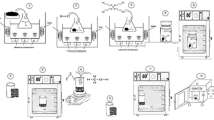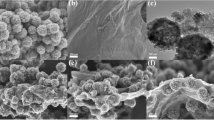Abstract
The intensive development of the petrochemical industry globally reflects the necessity of an efficient approach for oily sludge and wastewater. Hence, for the first time, the current study utilized magnetic waxy diesel sludge (MWOPS) to synthesize activated carbon coated with TiO2 particles for the removal of total petroleum hydrocarbons (TPH) and COD from oily petroleum wastewater (OPW). The photocatalyst was characterized using CHNOS, elemental analysis was performed using X-ray fluorescence spectroscopy (XRF), field emission scanning electron microscope (FESEM), high-resolution transmission electron microscope (HR-TEM), X-ray diffraction analysis (XRD), Fourier transform infrared spectrometer (FTIR), Raman, energy dispersive X-ray spectroscopy (EDX), X-ray photoelectron spectroscopy (XPS), MAP thermo-gravimetric analysis/differential thermo-gravimetric (TGA–DTG), Brunauer–Emmett–Teller (BET), diffuse reflectance spectroscopy (DRS), and vibrating sample magnetometer (VSM). The optimization of synthesized highly porous AC/Fe3O4/TiO2 photocatalyst was conducted considering the impacts of pH, temperature, photocatalyst dosage, and UVA6W exposure time. The results demonstrated the high capacity of the MWOPS with inherent magnetic potential and desired carbon content for the removal of 91% and 93% of TPH and COD, respectively. The optimum conditions for the OPW treatment were obtained at pH 6.5, photocatalyst dosage of 250 mg, temperature of 35 °C, and UVA6W exposure time of 67.5 min. Moreover, the isotherm/kinetic modeling illustrated simultaneous physisorption and chemisorption on heterogeneous and multilayer surfaces. Notably, the adsorption efficiency of the AC/Fe3O4/TiO2 decreased by 4% after five adsorption/desorption cycles. Accordingly, the application of a well-designed pioneering photocatalyst from the MWOPS provides a cost-effective approach for industry manufacturers for oily wastewater treatment.














Similar content being viewed by others
Availability of data and materials
The data and materials from the current study are available from the corresponding author on reasonable request.
References
Abyar H, Younesi H, Bahramifar N, Zinatizadeh AA (2018) Biological CNP removal from meat-processing wastewater in an innovative high rate up-flow A2O bioreactor. Chemosphere 213:197–204
Alghamdi YG, Krishnakumar B, Malik MA, Alhayyani S (2022) Design and preparation of biomass-derived activated carbon loaded TiO2 photocatalyst for photocatalytic degradation of reactive red 120 and ofloxacin. Polymers 14(5):880
Ariza-Tarazona MC, Villarreal-Chiu JF, Hernández-López JM, De la Rosa JR, Barbieri V, Siligardi C, Cedillo-González EI (2020) Microplastic pollution reduction by a carbon and nitrogen-doped TiO2: effect of pH and temperature in the photocatalytic degradation process. J Hazard Mater 395:122632
Arutanti O, Sari AL, Kartikowati CW, Sari AA, Arif AF (2022) Design and application of homogeneous-structured TiO2/activated carbon nanocomposite for adsorption–photocatalytic degradation of MO. Water Air Soil Pollut 233(4):1–13
Ashjar N, Keshavarzi B, Moore F, Soltani N, Hooda PS, Mahmoudi MR (2022) TPH and PAHs in an oil-rich metropolis in SW Iran: Implication for source apportionment and human health. Hum Ecol Risk Assess Int J 28(1):58–78
Bongiorno D, Ceraulo L, Di Stefano V, Avellone G, Indelicato S (2022) Total petroleum hydrocarbons (TPH) determination in surfactant stabilized marine water emulsions. ARKIVOC Online J Organ Chem. https://doi.org/10.24820/ark.5550190.p011.719
Brown TC, Bagheri A, Fellows CM (2023) Universal Langmuir and fractal analysis of high-resolution adsorption isotherms of argon and nitrogen on macroporous silica. Langmuir 39:1914–1926
Chand K, Cao D, Fouad DE, Shah AH, Lakhan MN, Dayo AQ, Sagar HJ, Zhu K, Mohamed AMA (2020) Photocatalytic and antimicrobial activity of biosynthesized silver and titanium dioxide nanoparticles: a comparative study. J Mol Liq 316:113821
Dalanta F, Kusworo TD (2022) Synergistic adsorption and photocatalytic properties of AC/TiO2/CeO2 composite for phenol and ammonia–nitrogen compound degradations from petroleum refinery wastewater. Chem Eng J 434:134687
Demir Ö, Gök A, Kırbaşlar Şİ (2022) Optimization of protocatechuic acid adsorption onto weak basic anion exchange resins: kinetic, mass transfer, isotherm, and thermodynamic study. Biomass Convers Biorefin. https://doi.org/10.1007/s13399-022-02573-3
Emilia Agustina T, Komala R, Faizal M (2022) Similarity Check_Application of TiO2 nano particles photocatalyst to degrade synthetic dye wastewater under solar irradiation
Esania Z, Younesi H, Nowrouzi M, Karimi-Maleh H (2022) Characterization and assessment of the photocatalytic activity of ZnO-Fe3O4/TiO2 nanocomposite based on MIL-125 (Ti) synthesized by mixed solvo-hydrothermal and sol-gel methods. J Water Process Eng 47:102750
Fekri MH, Mohamareh SI, Hosseini M, Mehr MR (2021) Modification of activated carbon (prepared from flaxseed) with Fe3O4, its application as adsorbent and antibacterial
Garg A, Chauhan A, Agnihotri C, Singh BP, Mondem V, Basu S, Agnihotri S (2023) Sunlight active cellulose/g-C3N4/TiO2 nano-photocatalyst for degradation of industrial dye and pharmaceutical drug in real wastewater
Govindhan P, Pragathiswaran C, Chinnadurai M (2018) A magnetic Fe3O4 decorated TiO2 nanoparticles application for photocatalytic degradation of methylene blue (MB) under direct sunlight irradiation. J Mater Sci Mater Electron 29(8):6458–6469
Haghgoo AA, Cheraghi M, Sobhanardakani S, Lorestani B, Izadkhah V (2022) Preparation of AC/KOH and AC/Fe3O4/ZnO nanocomposite from waste rice straw for the removal of cyclophosphamide from aqueous solutions. Toxin Rev 42:1–10
Karimi N, Mirbagheri SA, Nouri R, Bazargan A (2023) Sequential application of aerated electrocoagulation and γ-Fe2O3 nanoparticle adsorption for COD removal: consuming the least amount of energy and economic evaluation. Results Eng 17:100770
Khaksarian M, Bahmani M, Taherikalani M, Ashrafi B, Rafieian-Kopaei M, Abbasi N (2022) Biosynthesis of titanium dioxide nanoparticles using Hypericum perforatum and Origanum vulgare extracts and their main components, hypericin and carvacrol as promising antibacterial agents. J Tradit Chin Med 42(2):167
Lenore S, Clesceri AE, Greenberg ADE (1999) APHA standard methods for the examination of water and wastewater. American Public Health Association, Washington, DC
Ma CM, Hong GB, Lee SC (2020) Facile synthesis of tin dioxide nanoparticles for photocatalytic degradation of Congo red dye in aqueous solution. Catalysts 10(7):792
Masinga T, Moyo M, Pakade VE (2022) Removal of hexavalent chromium by polyethyleneimine impregnated activated carbon: Intra-particle diffusion, kinetics and isotherms. J Market Res 18:1333–1344
Mojoudi N, Soleimani M, Mirghaffari N, Belver C, Bedia J (2019) Removal of phenol and phosphate from aqueous solutions using activated carbons prepared from oily sludge through physical and chemical activation. Water Sci Technol 80(3):575–586
Moosavi S, Li RYM, Lai CW, Yusof Y, Gan S, Akbarzadeh O, Chowhury ZZ, Yue X-G, Johan MR (2020) Methylene blue dye photocatalytic degradation over synthesised Fe3O4/AC/TiO2 nano-catalyst: degradation and reusability studies. Nanomaterials 10(12):2360
Mousavi SE, Younesi H, Bahramifar N, Tamunaidu P, Karimi-Maleh H (2022) A novel route to the synthesis of α-Fe2O3@ C@ SiO2/TiO2 nanocomposite from the metal-organic framework as a photocatalyst for water treatment. Chemosphere 297:133992
Nazal MK, Ilyas M, Gijjapu D, Abuzaid N (2022) Treatment of water contaminated with petroleum hydrocarbons using a biochar derived from seagrass biomass as low-cost adsorbent: isotherm, kinetics and reusability studies. Sep Sci Technol 57:2358–2373
Parvathiraja C, Katheria S, Siddiqui MR, Wabaidur SM, Islam MA, Lai W-C (2022) Activated carbon-loaded titanium dioxide nanoparticles and their photocatalytic and antibacterial investigations. Catalysts 12(8):834
Pathak J, Singh P (2023) Adsorptive removal of congo red using organically modified zinc–copper–nickel ternary metal hydroxide: kinetics, isotherms and adsorption studies. J Polym Environ 31(1):327–344
Qu K, Huang L, Hu S, Liu C, Yang Q, Liu L, Li K, Zhao Z, Wang Z (2023) TiO2 supported on rice straw biochar as an adsorptive and photocatalytic composite for the efficient removal of ciprofloxacin in aqueous matrices. J Environ Chem Eng 11:109430
Rajendran S, Inwati GK, Yadav VK, Choudhary N, Solanki MB, Abdellattif MH, Yadav KK, Gupta N, Islam S, Jeon B-H (2021) Enriched catalytic activity of TiO2 nanoparticles supported by activated carbon for noxious pollutant elimination. Nanomaterials 11(11):2808
Rasouli K, Alamdari A, Sabbaghi S (2023) Ultrasonic-assisted synthesis of α-Fe2O3@TiO2 photocatalyst: optimization of effective factors in the fabrication of photocatalyst and removal of non-biodegradable cefixime via response surface methodology-central composite design. Sep Purif Technol 307:122799
Rastgar S, Rezaei H, Younesi H, Abyar H (2022) Low-cost magnetic char derived from oily sludge for methylene blue dye removal: optimization, isotherm, and kinetic approach. Adv Environ Technol. https://doi.org/10.22104/AET.2022.5795.1595
Tetteh EK, Rathilal S, Naidoo DB (2020) Photocatalytic degradation of oily waste and phenol from a local South Africa oil refinery wastewater using response methodology. Sci Rep 10(1):1–12
Ul Haq I, Ahmad W, Ahmad I, Shah A, Yaseen M, Muhammad T (2023) Integrated photocatalytic oxidation and adsorption approach for the robust treatment of refinery wastewater using hybrid TiO2/AC. Catalysts 13(1):193
Wang L, Xu Y, Zhao Z, Zhang D, Lin X, Ma B, Zhang H (2022) Analysis of pyrolysis characteristics of oily sludge in different regions and environmental risk assessment of heavy metals in pyrolysis residue. ACS Omega 7(30):26265–26274
Yaacob NA, Khasri A, Mohd Salleh NH, Mohd Jamir MR (2022) Optimization of AC/TiO2-Cu ternary composite preparation with enhanced UV light activity for adsorption–photodegradation of metronidazole via RSM-CCD. J Dispers Sci Technol 45:1–12
Zghal S, Jedidi I, Cretin M, Cerneaux S, Abdelmouleh M (2023) Adsorptive removal of rhodamine B dye using carbon graphite/CNT composites as adsorbents: kinetics, isotherms and thermodynamic study. Materials 16(3):1015
Zhang C, Chao L, Zhang Z, Zhang L, Li Q, Fan H, Zhang S, Liu Q, Qiao Y, Tian Y (2021) Pyrolysis of cellulose: evolution of functionalities and structure of bio-char versus temperature. Renew Sustain Energy Rev 135:110416
Zhu H, Chen S, Duan H, He J, Luo Y (2023) Removal of anionic and cationic dyes using porous chitosan/carboxymethyl cellulose-PEG hydrogels: optimization, adsorption kinetics, isotherm and thermodynamics studies. Int J Biol Macromol 231:123213
Funding
This research was carried out with the financial support of the Iran National Science Foundation (INSF grant No. 99026657). Also the authors give special thanks to the Gorgan and Tarbiat Modares university of Agricultural Sciences and Natural Resources.
Author information
Authors and Affiliations
Contributions
S. Rastgar: generated the idea, methodology, data curation, investigation writing—original draft preparation, H. Rezaei and H. Younesi: conceptualization, validation, investigation, H. Abyar: writing—review and editing. All authors have read and agreed to the published version of the manuscript.
Corresponding authors
Ethics declarations
Conflict of interest
The authors declare that they have no known competing financial interests or personal relationships that could have appeared to influence the work reported in this paper.
Ethical approval
Not applicable.
Consent to participate
Participation in the study was voluntary; all participants agreed to participate in the study.
Consent for publication
The authors approved the version to be published.
Additional information
Publisher's Note
Springer Nature remains neutral with regard to jurisdictional claims in published maps and institutional affiliations.
Supplementary Information
Below is the link to the electronic supplementary material.
Rights and permissions
Springer Nature or its licensor (e.g. a society or other partner) holds exclusive rights to this article under a publishing agreement with the author(s) or other rightsholder(s); author self-archiving of the accepted manuscript version of this article is solely governed by the terms of such publishing agreement and applicable law.
About this article
Cite this article
Rastgar, S., Rezaei, H., Younesi, H. et al. Preparation of superparamagnetic AC/Fe3O4/TiO2 nanoparticles from magnetic waste oily petroleum sludge (MWOPS): comprehensive characterization, H2 production, design batch photoreactor, and treatment of oily petroleum wastewater (OPW) under UVA light. Carbon Lett. (2024). https://doi.org/10.1007/s42823-024-00711-7
Received:
Revised:
Accepted:
Published:
DOI: https://doi.org/10.1007/s42823-024-00711-7




